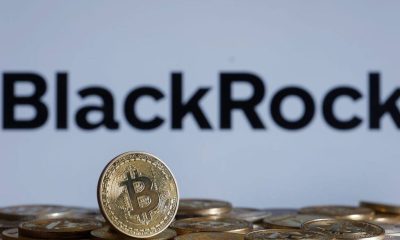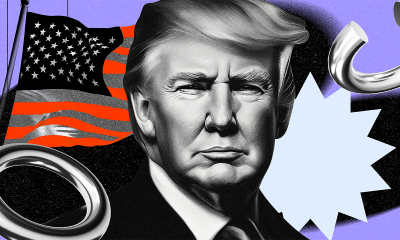Market
This Is How Wealth Gets Democratized
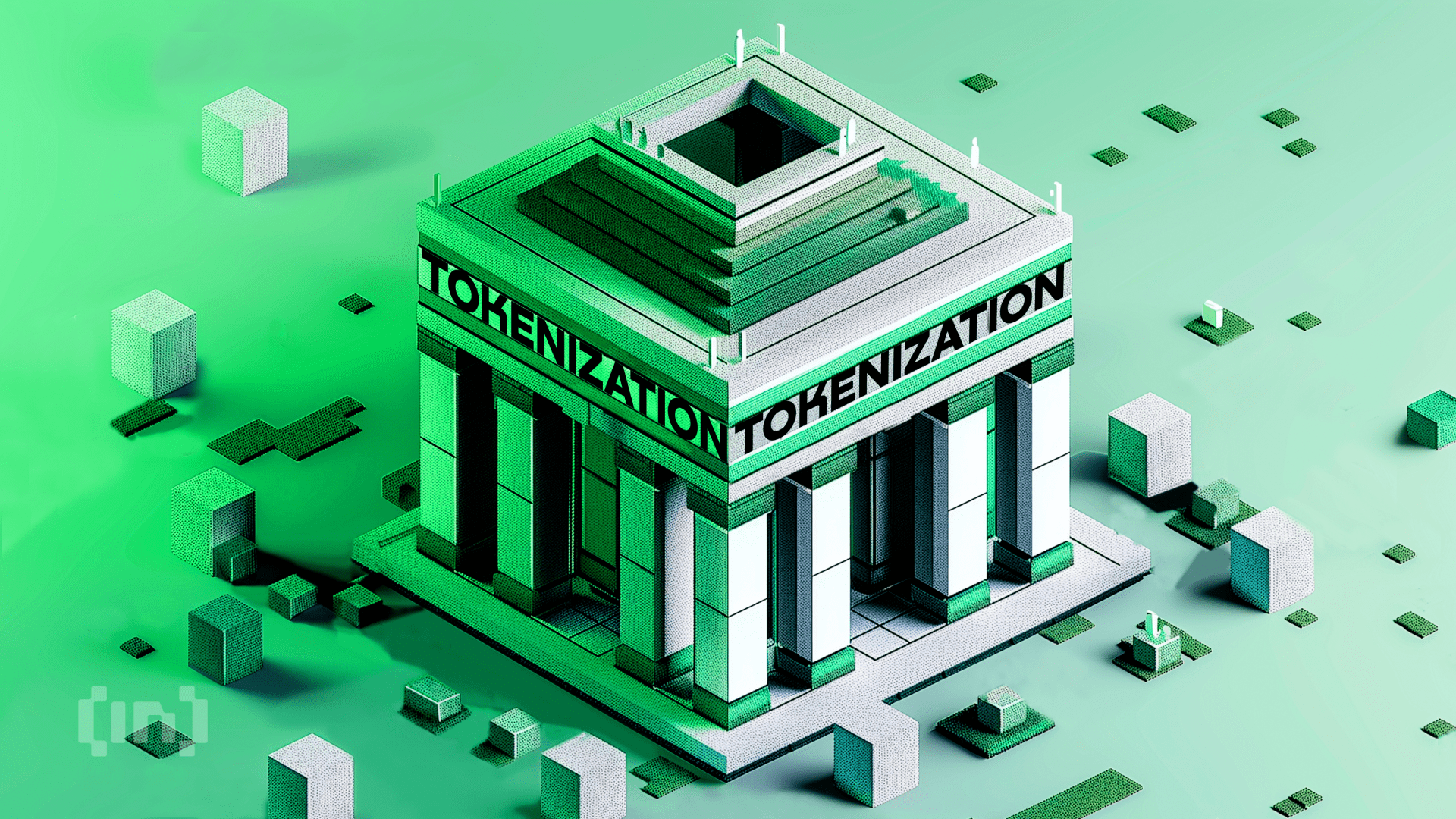
While taking an evening stroll, Alex observes as yet another old real estate property is renovated into luxury condos. Having lived in the neighborhood his entire life, he has seen it transform from a community of small homes to an area dominated by high-rises and exclusive properties.
These advances have primarily benefited high-net-worth individuals and institutional investors. Meanwhile, people like Alex have no choice but to remain on the sidelines, unable to afford the soaring property costs.
Currently, financial inequality is swiftly increasing worldwide. The rich are getting richer, while the poor are getting poorer. The financial system is structured in such a way that wealth generation is predominantly reserved for the affluent.
How Tokenization Can Democratize Wealth Creation
Consequently, the broader populace has scant opportunities to invest in high-value assets like real estate or fine art. This paradigm exacerbates wealth disparity.
According to a Statista report, the top 10% of earners in the United States possess 67 percent of the nation’s wealth. In stark contrast, the bottom 50 percent own just 2.5%.
Read more: What Are Tokenized Real-World Assets (RWA)?

Tokenization, however, could dramatically reshape the financial sector. Alex and others like him could own a piece of the properties for the first time, reshaping their community. This technology promises to democratize investment, allowing more residents to benefit financially from the growth and changes in their neighborhoods.
In an interview with BeInCrypto, John Patrick Mullin, co-founder of MANTRA—a layer-1 blockchain dedicated to the tokenization of real-world assets (RWAs)—explains how this technology is transformative.
“Tokenization is a powerful catalyst for democratizing wealth creation and dismantling historical barriers to retail investment in high-value real world assets,” Mullin told BeInCrypto.
Furthermore, by fractionalizing these assets and tokenizing them on-chain, MANTRA seeks to level the playing field for individuals with limited capital. The principle behind this innovation is straightforward yet transformative. Illiquid assets such as real estate or fine art are tokenized into digital tokens, each representing a fractional interest in the asset.
“Illiquid assets are made more accessible by being tokenized as digital tokens, with each individual token representing a fractionalized interest in the larger real estate or fine art asset,” Mullin adds.
Read more: Where To Buy Tokenized or Fractionalized Real Estate and Art
This shift from exclusive ownership to fractionalized investing allows for a more equitable distribution of wealth. Several investors can pool resources to purchase portions of a high-value asset, thereby holding a stake in potentially lucrative markets previously dominated by the wealthy. Mullin emphasizes that this method of fractional ownership is integral to fair wealth distribution.
Challenges With Tokenization
Despite RWAs’ potential to democratize investment, challenges remain. Particularly, there is the risk of tokenization merely becoming another tool for the affluent to consolidate wealth. Mullin notes the importance of inclusive practices and strong regulatory frameworks in addressing this.
“We implement several measures to eliminate gatekeeping and mitigate this risk,” Mullin states.
These measures include establishing regulations for investor due diligence, educating diverse investor populations to promote participation, and implementing transparent governance models prioritizing all stakeholders’ interests.
Moreover, the blockchain technology underpinning this innovation adds another layer of transparency and security. It makes on-chain data available for anyone to analyze, which helps promote fairness and eliminate malpractices like insider trading. This openness is essential for fostering trust among a broad base of investors.
Read more: What is The Impact of Real World Asset (RWA) Tokenization?
Additionally, education and accessibility are critical for the widespread adoption of tokenized RWAs, particularly among underserved communities. A comprehensive strategy that includes educating potential investors about the opportunities and risks associated with RWAs and supportive infrastructure can enhance participation.
Lastly, tackling regulatory challenges remains a crucial step toward a stable environment for tokenization. Mullin anticipates key developments, particularly increased compliance across jurisdictions. These developments will be fueled by legal frameworks that foster a more stable environment for tokenization.
The Current State of the RWA Market
In 2024, the market response to RWAs has been notably positive, with interest from major institutional players such as BlackRock, Fidelity, and Franklin Templeton. According to CoinGecko, the market capitalization of RWA crypto tokens is nearing $8 billion.
Read more: How To Invest in Real-World Crypto Assets (RWA)?

Also, the tokenized government securities market alone has surpassed $2.14 billion. These data illustrate the growing acceptance and integration of RWAs into the broader financial ecosystem.
Read more: Crypto Regulation: What Are the Benefits and Drawbacks?
Indeed, the tokenization of RWAs stands out as a potentially revolutionary force in the financial market. It can bridge the gap between traditional and decentralized finance, thus offering a more inclusive and equitable economic future.
“Tokenization may well be the final piece in the puzzle for equitable wealth distribution,” Mullin concludes.
Disclaimer
Following the Trust Project guidelines, this feature article presents opinions and perspectives from industry experts or individuals. BeInCrypto is dedicated to transparent reporting, but the views expressed in this article do not necessarily reflect those of BeInCrypto or its staff. Readers should verify information independently and consult with a professional before making decisions based on this content. Please note that our Terms and Conditions, Privacy Policy, and Disclaimers have been updated.
Market
Report Alleges Massive Meme Coin Sniping on Pump.fun

According to a new report from Pine Analytics, token deployers on Pump.fun systematically funded sniper wallets to buy their own meme coins. This impacted over 15,000 token launches on the platform.
These sniper wallets operated primarily during US trading hours, executing standardized, profitable strategies. Unrelated bot activity obscures their behavior, making it extremely difficult to isolate these wallets—and they can readily adapt to new countermeasures.
Snipers Roam Free on Pump.fun Meme Coins
Pump.fun has remained one of the most popular meme coin launchpads on Solana despite persistent controversies and other criticism.
However, Pine Analytics’ new report has uncovered a new controversy, discovering systematic market manipulation on the platform. These snipes include as much as 1.75% of all launch activity on Pump.fun.
“Our analysis reveals that this tactic is not rare or fringe — over the past month alone, more than 15,000 SOL in realized profit was extracted through this method, across 15,000+ launches involving 4,600+ sniper wallets and 10,400+ deployers. These wallets demonstrate unusually high success rates (87% of snipes were profitable), clean exits, and structured operational patterns,” it claimed.
Solana meme coin deployers on Pump.fun follow a consistent pattern. They fund one or more sniper wallets and grant them advance notice of upcoming token launches.
Those wallets purchase tokens in the very first block and then liquidate almost immediately—85% within five minutes and 90% in just one or two swap events.

Pump.fun meme coin developers exploit this tactic to create the appearance of immediate demand for their tokens. Retail investors, unaware of the prior sell‑off, often purchase these tokens after the snipe, giving developers an unfair advantage. This constitutes market manipulation and erodes trust in the platform.
Pine Analytics had to carefully calibrate its methods to identify genuine snipers. Apparently, 50% of meme coin launches on Pump.fun involve sniping, but most of this is probably bots using the “spray and pray” method.
However, by filtering out snipers with no direct links to developer wallets, the firm missed projects that covered their tracks through proxies and burners.
In other words, the meme coin community does not have adequate defenses against systematic abuse on Pump.fun. There are a few possible ways that the platform could flag repeat offenders and sketchy projects, but adaptive countermeasures could defeat them. This problem demands persistent and proactive action.
Unfortunately, it may be difficult to enact such policies. Meme coin sniping is so systematic that Pump.fun could only fight it with real commitment.
Analysts think that building an on-chain culture that rewards transparency over extraction is the best long-term solution. A shift like that would be truly seismic, and the meme coin sector might not survive it.
Disclaimer
In adherence to the Trust Project guidelines, BeInCrypto is committed to unbiased, transparent reporting. This news article aims to provide accurate, timely information. However, readers are advised to verify facts independently and consult with a professional before making any decisions based on this content. Please note that our Terms and Conditions, Privacy Policy, and Disclaimers have been updated.
Market
Solana Leads Blockchain Metrics as SOL Momentum Builds

Solana (SOL) continues to show strength across multiple fronts, maintaining a bullish structure on its Ichimoku Cloud chart while gaining momentum in key market metrics. The BBTrend indicator has turned higher again, signaling renewed buying pressure after a brief cooldown.
On-chain activity remains strong, with Solana leading all blockchains in DEX volume and dominating fee generation thanks to the explosive growth of meme coins and launchpad activity. With SOL now trading above a key resistance level, the path is open for further upside—though a loss of momentum could still trigger a retest of lower supports.
Solana Maintains Bullish Structure, but Momentum Faces Key Test
On Solana’s Ichimoku Cloud chart, the price is currently above the Kijun-sen (red base line) but has dipped below the Tenkan-sen (blue conversion line), signaling weakening short-term momentum.
The flattening Tenkan-sen and price behavior suggest possible consolidation or the early stages of a pullback. Still, with the price holding above the Kijun-sen, medium-term support remains intact.
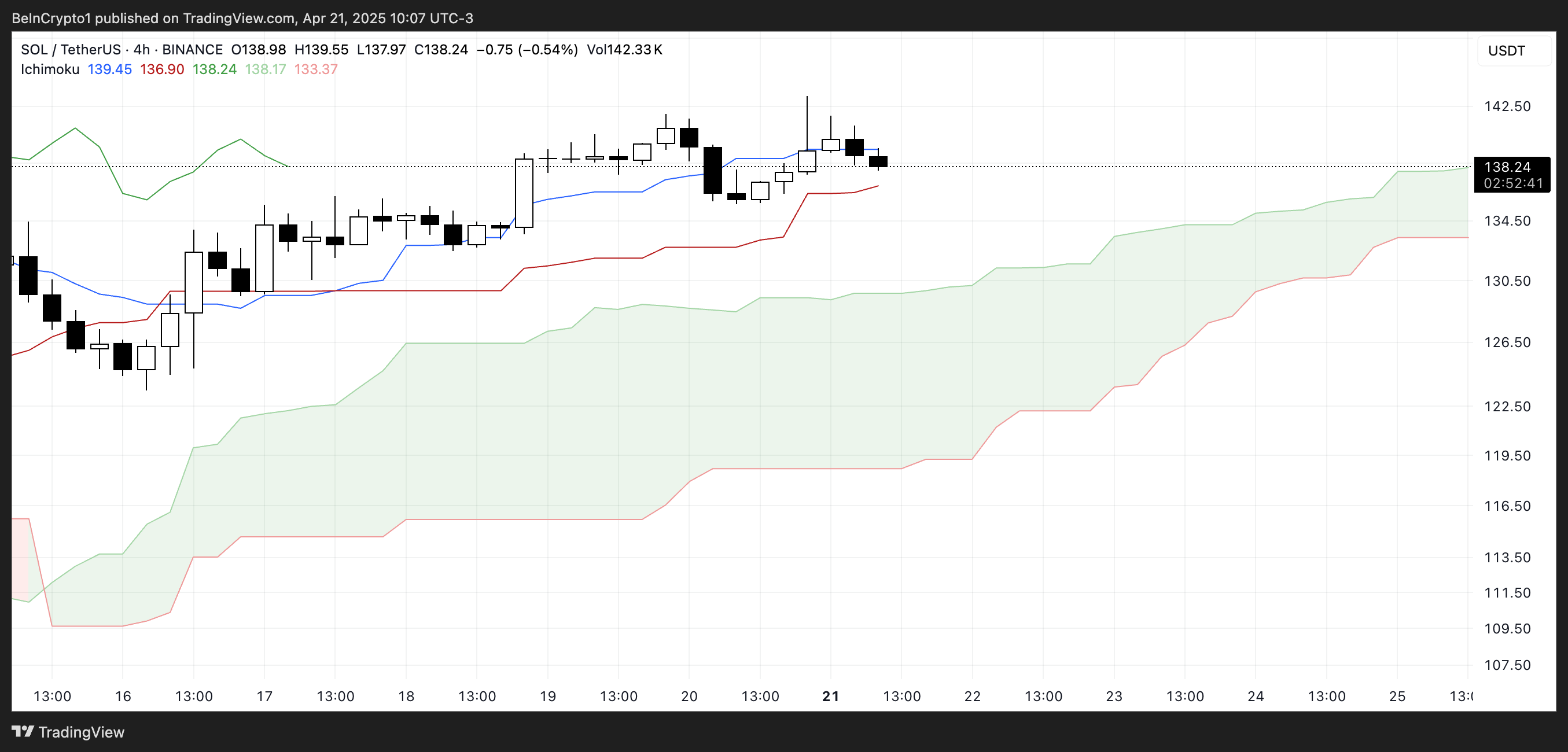
The overall Ichimoku structure remains bullish, with a thick, rising cloud and leading span A well above span B—indicating strong underlying support.
If Solana finds support at the Kijun-sen and climbs back above the Tenkan-sen, the uptrend could regain strength; otherwise, a test of the cloud’s upper boundary may follow.

Meanwhile, Solana’s BBTrend is currently at 6, extending nearly ten days in positive territory after peaking at 17.5 on April 14. The recent increase from 4.26 to 6 suggests renewed bullish momentum following a brief cooldown.
BBTrend, or Bollinger Band Trend, tracks the strength of price movement based on Bollinger Band expansion.
Positive values like the current one point to an active uptrend, and if the BBTrend continues to rise, it could signal stronger momentum and potential for another upward move.
Solana Dominates DEX Volume and Fee Generation as Meme Coins Drive Ecosystem Growth
Solana has once again claimed the top spot among all chains in DEX volume, recording $15.15 billion over the past seven days. The combined total of Ethereum, BNB, Base, and Arbitrum reached $22.7 billion.

In the last 24 hours alone, Solana saw $1.67 billion in volume, largely fueled by its booming meme coin ecosystem and the ongoing launchpad battle between PumpFun and Raydium. Adding to this good momentum, Solana recently surpassed Ethereum in Staking Market Cap.

When it comes to application fees, Solana’s momentum is just as clear. Four of the top ten fee-generating apps over the past week—PumpFun, Jupiter, Jito, and Meteora—are Solana-focused.
Pump leads the pack with nearly $18 million in fees alone.
Solana Breaks Key Resistance as Uptrend Targets Higher Levels, but Risks Remain
Solana has finally broken above its key resistance at $136, flipping it into a new support level that was successfully tested just yesterday.
Its EMA lines remain aligned in a bullish setup, suggesting the uptrend is still intact.
If this momentum continues, SOL price could aim for the next resistance zones at $147 and $152—levels that, if breached, open the door to a potential move toward $179.
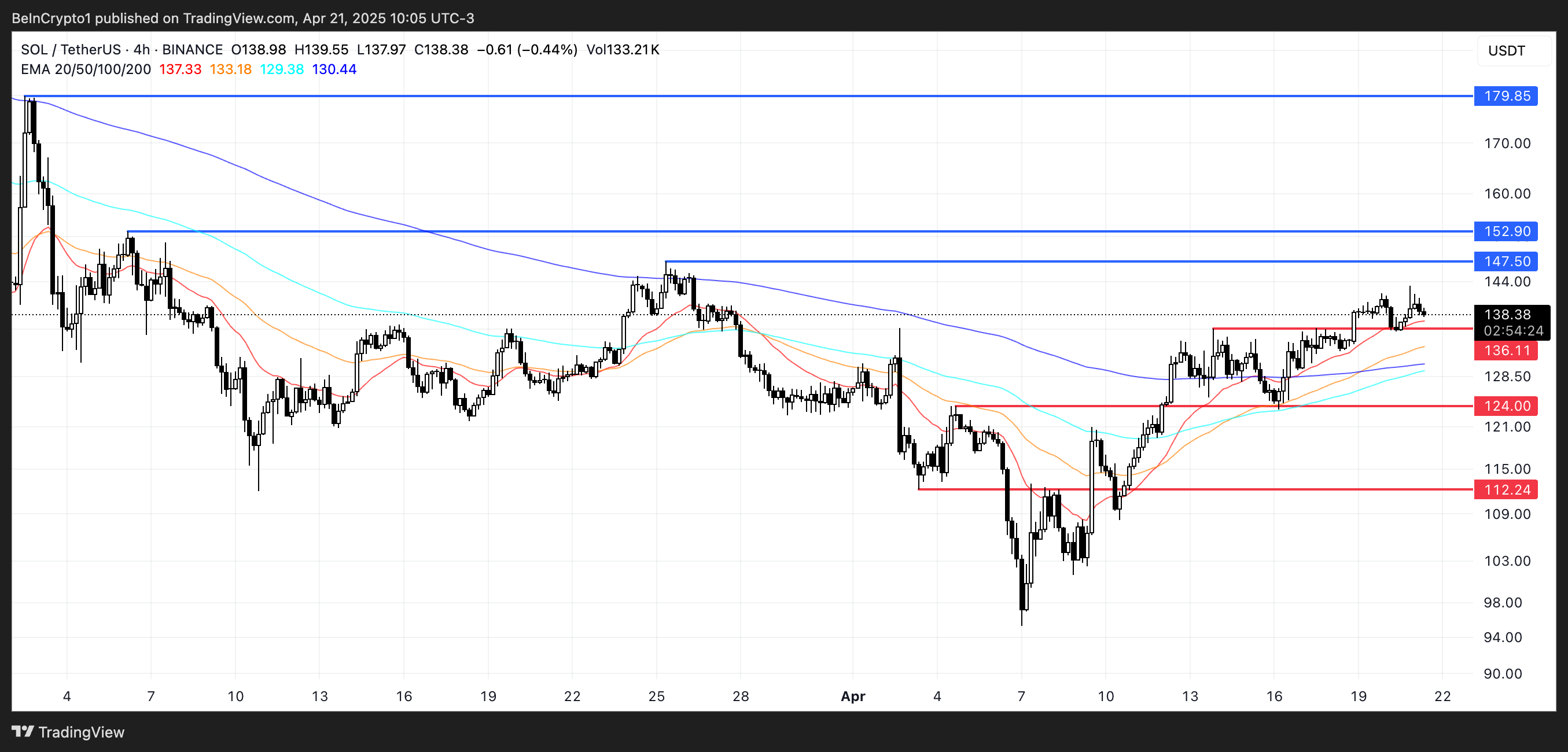
The current structure favors buyers, with higher lows and strong support reinforcing the trend.
However, if momentum fades, a retest of the $136 support is likely.
A breakdown below that level could shift sentiment, exposing Solana to deeper pullbacks toward $124 and even $112.
Disclaimer
In line with the Trust Project guidelines, this price analysis article is for informational purposes only and should not be considered financial or investment advice. BeInCrypto is committed to accurate, unbiased reporting, but market conditions are subject to change without notice. Always conduct your own research and consult with a professional before making any financial decisions. Please note that our Terms and Conditions, Privacy Policy, and Disclaimers have been updated.
Market
Crypto Firms Donated $85 million in Trump’s Inauguration
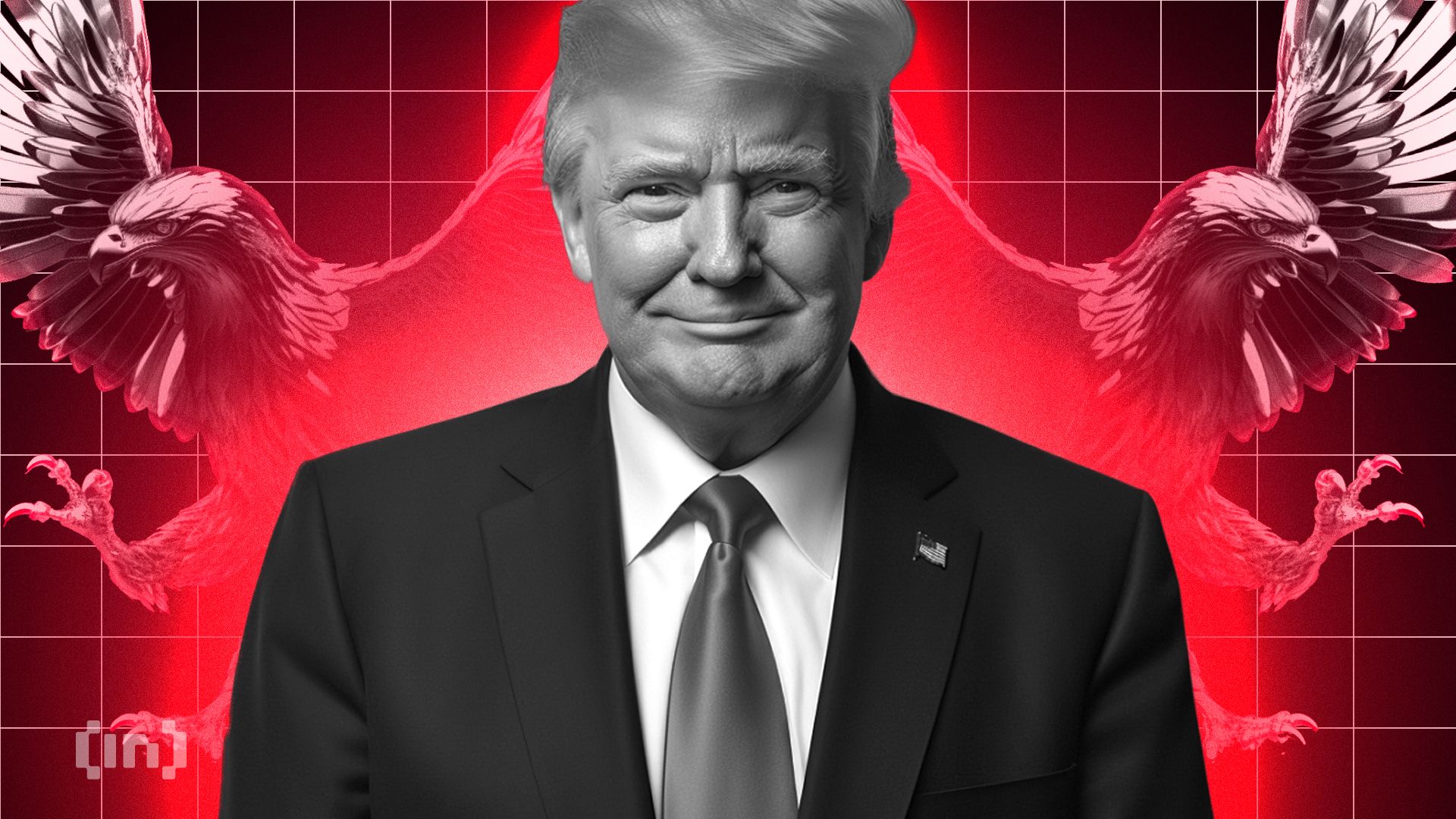
According to a new report, 15 firms and individuals from the crypto industry donated more than $100,000 to President Trump’s Inauguration, totaling over $85 million.
Almost all of these companies apparently received direct or indirect benefits from Trump’s administration. This includes dropped legal proceedings, lucrative business partnerships, participation in Trump’s Crypto Summit, and more.
Crypto Industry Went All-In on Trump’s Inauguration
Since promising to bring friendlier regulations on the campaign trail, Donald Trump attracted a reputation as the Crypto President.
Trump’s Inauguration festivities included a “Crypto Ball,” and several prominent firms made donations for these events. Today, a report has compiled all crypto-related contributions of over $100,000, revealing some interesting facts.

Since taking office, President Trump and his family have been allegedly involved in prominent crypto controversies, and these donations may be linked to several of them.
For example, eight of the donors, Coinbase, Crypto.com, Uniswap, Yuga Labs, Kraken, Ripple, Robinhood, and Consensys, had SEC investigations or lawsuits against them closed since Trump’s term began.
The commission might have dropped its probe against these companies anyway due to its changing stance on crypto enforcement. However, being in the President’s good books likely helped the process.
Further Alleged Benefits for Donors
In other words, nearly half the firms that made donations to Trump’s Inauguration have seen their legal problems cleared up quickly. This isn’t the only regulation-related benefit they allegedly received.
Circle, for example, recently made an IPO after openly stating that Trump’s Presidency made it possible. Galaxy Digital received SEC approval for a major reorganization, a key step for a NASDAQ listing.
Other donors, such as Crypto.com and ONDO, got more direct financial partnerships with businesses associated with the Trump family.
Previously, Ripple’s CEO, Brad Garlinghouse, anticipated a crypto bull market under Trump. Also, XRP, Solana, and Cardano were all unexpectedly included in the US Crypto Reserve announcement.
All three of these companies made major donations to Trump’s Inauguration.
It seems that most of the firms involved got at least some sort of noticeable benefit from these donations. Donors like Multicoin and Paradigm received invitations to Trump’s Crypto Summit, while much more prominent groups like the Ethereum Foundation got snubbed.
Meanwhile, various industry KOLs and community members have already alleged major corruption in Trump’s crypto connections.
While some allegations might lack substantial proof, the crypto space has changed dramatically under the new administration, for both good and bad.
Disclaimer
In adherence to the Trust Project guidelines, BeInCrypto is committed to unbiased, transparent reporting. This news article aims to provide accurate, timely information. However, readers are advised to verify facts independently and consult with a professional before making any decisions based on this content. Please note that our Terms and Conditions, Privacy Policy, and Disclaimers have been updated.


